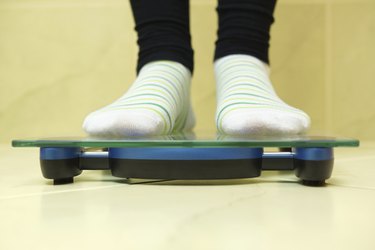
Although not FDA-approved for weight loss, naltrexone and topamax seem to induce weight loss in a majority of individuals. You must have a valid medical prescription to obtain them. If you feel like they might be right for you, you can ask your doctor to prescribe either drug for you off-label. Keep in mind, however, that because these drugs have not yet been approved in the treatment of obesity, you may experience adverse reactions that are not yet known to occur.
Naltrexone and Weight Loss
Video of the Day
Naltrexone belongs to a class of drugs called opioid antagonists. It is used to treat alcoholism and opioid dependence by preventing the body from craving those substances. Naltrexone causes weight loss by reducing the amount of food you eat. It has decreased food intake by up to 30 percent in some individuals, according to a drug evaluation published in the August 2009 issue of "Expert Opinion on Pharmacotherapy." However, some individuals found no decrease in food intake or weight loss. Naltrexone seems to work best when used in combination with bupropion, an antidepressant drug.
Video of the Day
Topamax and Weight Loss
Topamax, known generically as topiramate, is a drug that is used to treat certain kinds of seizures, mood disorders and to prevent migraine headaches. It seems to induce weight loss by suppressing your appetite and affecting certain hormones in your body; namely, insulin, ghrelin and leptin. Topamax can double the amount of weight you'd lose on your own, according to a study published in the June 2003 issue of "Obesity Research." The amount of weight loss experienced is dependent on the dose. You're more likely to lose a greater percentage of weight if you are on a high dose regimen. Weight loss as high as 56 lbs within a 3-month period has been noted in morbidly obese individuals.
Dosage
Topamax has induced weight loss at a variety of different doses. Doses as low as 64 mg a day have been effective, though doses of at least 150 mg per day appear to be most effective, according to case reports published in the June 2000 issue of "The Primary Care Companion to the Journal of Clinical Psychiatry." Naltrexone has been shown to be effective at doses of 16 mg and 32 mg per day, but only in combination with 360 mg of bupropion. Naltrexone seems to be more effective at a higher dose.
Adverse Effects
Topamax can cause a variety of unpleasant symptoms, most commonly drowsiness, problems with memory and concentration, and numbness and tingling of the skin. Gastrointestinal symptoms, such as nausea, vomiting, diarrhea, gas and constipation, have been noted. Serious adverse effects include trouble breathing, irregular heartbeat and blurred or double vision. Naltrexone also carries a host of side effects, the most common being nausea, headache and constipation, according to a study published in the August 2010 issue of "The Lancet." Other symptoms include infections of the upper respiratory tract, dizziness, insomnia, depression, anxiety, dry mouth, vomiting and diarrhea.